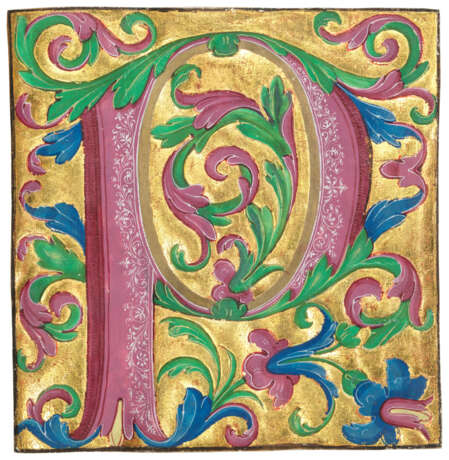Giovanni Pietro Birago (active 1470s-1513); Workshop of the Master of Cardinal Antoniotto Pallavicini (active 1492-1507); and an artist from the `Scuola degli Angeli`
12.07.2023 00:00UTC +00:00
Classic
Vendu
8820GBP £ 8 820
| Auctioneer | CHRISTIE'S |
|---|---|
| Lieu de l'événement | Royaume-Uni, London |
| Commission | see on Website% |
Archive
La vente aux enchères est terminée. Vous ne pouvez plus enchérir.

ID 993317
Lot 26 | Giovanni Pietro Birago (active 1470s-1513); Workshop of the Master of Cardinal Antoniotto Pallavicini (active 1492-1507); and an artist from the 'Scuola degli Angeli'
Valeur estimée
£ 3 000 – 5 000
Three large initials and one leaf from Italian choirbooks: a floral initial ‘S’ and ‘G’, and an illuminated initial 'P' cut to shape; and an illuminated initial ‘G’ on a full leaf from a Gradual [Italy, end of 15th / beginning 16th century]
A group of illuminated initials from Italian choirbooks, including examples of the sumptuous work of the great court illuminator Giovanni Pietro Birago.
Three initials cut from choirbooks and a leaf from a Gradual: (i) a ‘P’ painted in purple-red, green, and blue, with fine white ornament, on a gold ground, 115 × 112 mm. Reverse with one partial line of text '[...]er retrib[...]', and 19th?-century initials in ink and pencil 'J.K.D.' (perhaps J. K. D. Wingfield-Digby, d.1904) (ii) an ‘S’ incorporating bearded male faces, 171 x 167mm. The reverse with one lacework initial 'D' and two fragmentary lines of text and music, 'Dico [autem vo]bis amicis', possibly for the Common of Apostles (iii) a ‘G’ enclosing three large flowers on stem, 169 x c.181mm. The reverse with two partial lines of text and music from Psalm 88 '[in] eternum manebit [et thronu]s eius sicut sol in [conspectu meo]' and (iv) an illuminated initial 'G' on a leaf from a Gradual, 361 x 243mm. 8 lines of text and music, the initial introducing the antiphon for first Vespers on Saturday preceding Trinity Sunday (the first Sunday after Pentecost): ‘Gloria tibi trinitas equalis una deitas […]’, foliated in 16th(?)-century ink ‘126’ and inscribed in modern pencil ‘78’.
Provenance:
The initial ‘P’ was ‘The Property of a Lady’, sold at Sotheby's, 8 July 1970, lot 3.
Illumination:
The two cuttings 'S' and 'G' are the sumptuous work of Giovanni Pietro Birago, illuminator and engraver for the Sforza court active in Brescia, Venice and Milan. His earliest works are three signed choir books from Brescia Cathedral (Brescia, Pin. Civica Tosio-Martinengo, MSS 22, 23, and 25). The two initials are similar to an initial 'S' with the Presentation in the Temple at the Nelson-Atkins Museum of Art, William Rockhill Nelson Trust, 33-1363.
The cut initial 'P' is reminiscent of the work of the Master of Cardinal Antoniotto Pallavicini (cuttings from one of his Missals went through the collections of Luigi Celotti and William Ottley - a number of border fragments and a miniature are now in Cambridge, Marlay cuttings 36a-c, 37a-c, 38a-b and Z.1. Another Missal with the Mass of Christmas is in Madrid, Biblioteca Nacional, MS Vitr. 22-7. On these see E. De Laurentiis, The Lost Manuscripts from the Sistine Chapel, 2011, no 17, pp.152-167.)
The leaf from a Gradual is Florentine, and the elegant acanthus initial is clearly attributable to an artist working within the stylistic conventions often, rather imprecisely, called 'Scuola degli Angeli', after the Camaldolese monastery, Santa Maria degli Angeli, onetime house of Don Silvestro dei Gherarducci and Lorenzo Monaco.
| Artiste: | Giovanni Pietro Birago (XVe siècle - XVIe siècle) |
|---|---|
| Lieu d'origine: | Italie, Europe |
| Catégorie maison de vente aux enchères: | Manuscrits médiévaux et de la Renaissance |
| Artiste: | Giovanni Pietro Birago (XVe siècle - XVIe siècle) |
|---|---|
| Lieu d'origine: | Italie, Europe |
| Catégorie maison de vente aux enchères: | Manuscrits médiévaux et de la Renaissance |
| Adresse de l'enchère |
CHRISTIE'S 8 King Street, St. James's SW1Y 6QT London Royaume-Uni | |
|---|---|---|
| Aperçu |
| |
| Téléphone | +44 (0)20 7839 9060 | |
| Commission | see on Website | |
| Conditions d'utilisation | Conditions d'utilisation |














